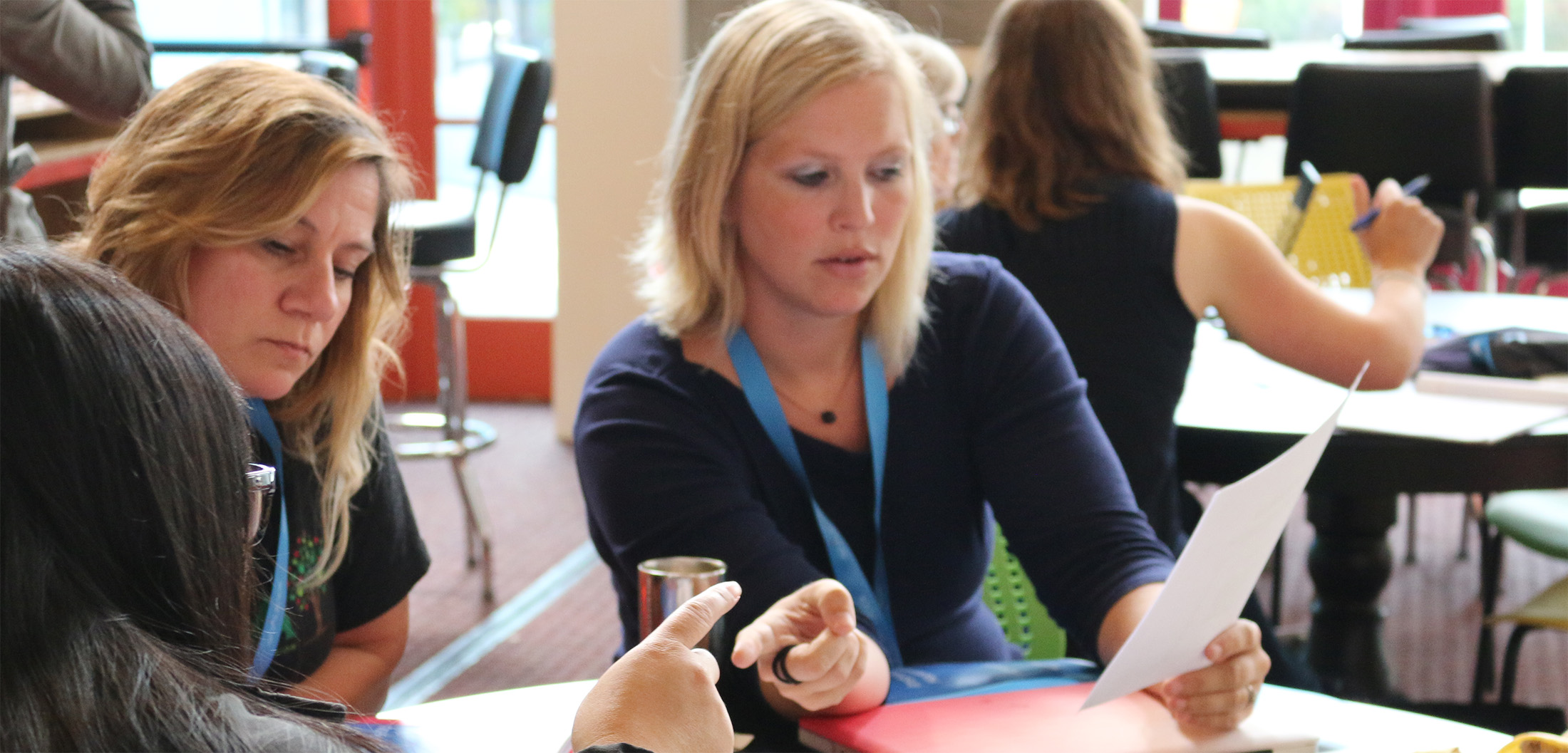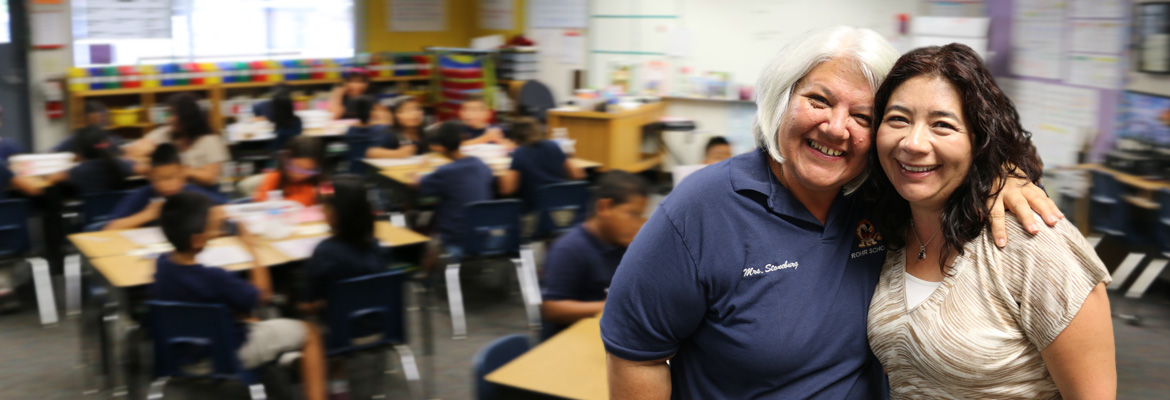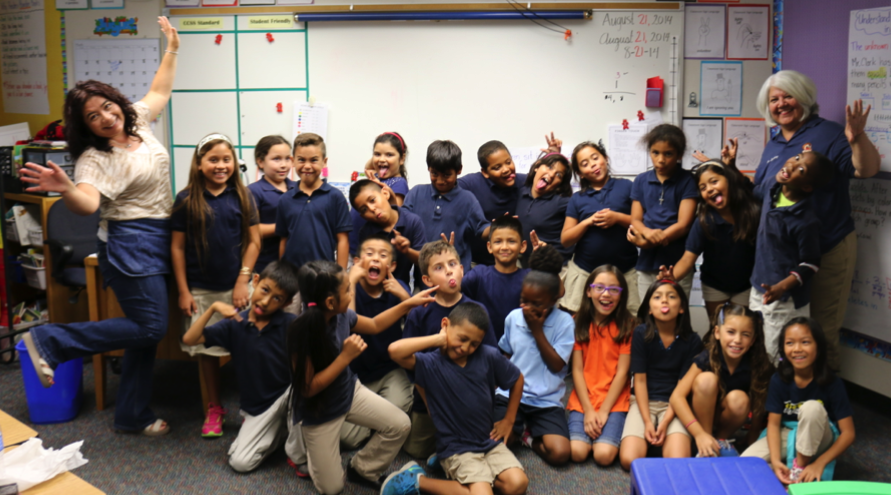
|
by Justin Su March 24, 2015 |
This school year, the Special Education staff at Campbell is starting with a month full of professional enrichment activities with Goalbook. Last Wednesday, staff gathered for part one of a four-part series on Instructional Leadership, which will continue on the first three Wednesdays in September. Campbell is using Goalbook this year to support teachers as the district shifts to Common Core. Another focus for Campbell’s staff this year is to use CCSS as an opportunity to foster collaboration between special education and general education teachers. In the words of CUSD’s Superintendent, Eric Andrew:
I am excited because for the first time we can truly meet the needs of all kids. Goalbook has allowed us to integrate the instructional practice for our general ed and our special populations, and ensure that all our students are taught to think critically and have the joy of learning. It is phenomenal.
The focus of the first session was demystifying Common Core and setting measurable goals for students using Goalbook’s Toolkit. The remainder of the sessions will include a workshop on crafting present level of performance statements, a refresher of Universal Design for Learning, and training on integrating Social and Emotional Core Competencies into students’ personalized learning plans, respectively. In addition to the workshops being held on-site, Goalbook supports educators with its tools, Pathways and Atlas, which are based on leading academic research and designed for educators to use when planning instruction.

|
by Justin Su September 16, 2014 |
When Mariana Stoneburg was faced with the challenge of teaching in a full inclusion setting, she felt lost.
Her school was not meeting NCLB guidelines and struggling to meet AYP with large ELD and SPED student populations. After several years of teaching as a Special Educator who pulled students out of traditional classrooms for one-on-one support, she was skeptical: with no experience facilitating inclusion and little training offered, she felt the impulse to learn more in an effort to help her students. Mariana took advantage of a professional development opportunity and enrolled in courses to learn more about how she could help her students access curriculum in a general education setting, where she first became aware of Universal Design for Learning.
Goalbook has opened up lots of ideas for me – every time I log in, I came out with something new, something that makes learning accessible to every student.
The UDL framework piqued her interest, and Mariana assumed a leadership role for other resource teachers in her building as they moved towards full inclusion. But as her practice began to shift, she still felt under-resourced when trying to develop new strategies for students with specific needs. The district provided a goal bank with a basic template for preparing for IEPs, but Mariana was frustrated by the lack of impact her planning was having on instruction.

[nggallery id=2]
“I found myself on autopilot, looking for something to teach my kids. I’d breeze through and write learning objectives without substance because I knew I had this very basic template.”
Then, Common Core came along. If it was difficult to make learning accessible for all students before, the new set of standards added a new dimension to the challenges Mariana and her colleagues faced. Teachers were now spending hours trying to decipher the most effective strategies that met the complexity and rigor of Common Core. Searching for help, Mariana turned to the web, where she found Goalbook.
Not only did Goalbook help Mariana align her instruction to Common Core with ease and save her time, it transformed her practice.
Goalbook Supports Teachers in Chula Vista Elementary School District from goalbookapp on Vimeo.
Most important, Goalbook has helped Mariana to have an impact on every student in the inclusion classroom – not just the 17 who are on her case load.
Mariana works with students in cooperation with Eudelia Torres, a third grade teacher at her school. She recalls an early example of UDL in practice: several years ago, she and Eudelia developed behavioral cue cards for a student with autism. “We developed it for a specific student, but I noticed that it also worked for the child squirming in her seat and the ELL student,” she explains. “Today, you will still see that chart on the ledge at the front of the classroom.”
Beyond the laminated flip chart at the front of the room, Eudelia’s classroom management techniques are also closely aligned to the UDL framework. She engages students by blowing a train whistle to signal when it’s time to line up, squeaking a toy attached to her belt to direct students’ attention, and chiming a silver wand when the class is too loud. Students don’t just raise their hands: throughout the room, a class-specific vocabulary of hand signals allows the teachers to determine if a hand is being raised as a bathroom request, because the student has a question, or – as is often the case – to volunteer to share with the class. Each chart, sign, and management technique is designed to foster an encouraging, collaborative environment where all students are engaged in high-level learning.
One example was a typical lesson on Common Core math, where students were learning how to represent the transitive property of multiplication using arrays. When Mariana demonstrated that an array could be portrayed both horizontally and vertically by rotating the small whiteboard she was using with a small group of students for the whole class, one young student took note. After returning to their seats to practice together, students returned to the carpet. One volunteered to share his work, and when asked to defend his answer by Eudelia, he responded by rotating his whiteboard – just as Mariana had done – as he remarked “I saw Mrs. Stoneburg do this.”
After using a free trial, recommending Goalbook to her colleagues, Mariana’s district officially partnered with Goalbook. Today, in Eudelia’s classroom, it’s evident that all students can access the rigor of Common Core – regardless of their individual needs. It is also clear that students are engaged in their learning: they assist one another, ask questions, present for each other, and demonstrate mastery at varied levels of rigor.
|
by Justin Su August 17, 2014 |
Goalbook has expanded its web-based platform, Toolkit, to include research-based resources that allow teachers to better address social emotional learning (SEL) in the classroom. With the new release, Goalbook continues its mission of empowering teachers to transform instruction for all students.
A growing body of research underscores the importance of SEL in classrooms: a 2011 report published by The Society for Research in Child Development observed a marked improvement in academic achievement for students who participated in SEL programs. The nonprofit research and policy organization, Collaborative for Academic, Social, and Emotional Learning (CASEL), states that social emotional learning has proven effective in urban, suburban and rural settings and across all age groups.
“Our teachers love the UDL strategy wizard — it helps them discover highly-effective, research-based strategies to enable achievement for our diverse student population.”
Goalbook’s Toolkit, which integrates instructional technology, academic research and ongoing professional development, allows teachers to easily incorporate SEL skill development within the context of their classrooms. All resources incorporate the Universal Design for Learning (UDL) framework for providing multiple means of access.
“Goalbook makes it easy for teachers to include social emotional learning as a component of classroom instruction,” said Ann Nason, supervisor of Special Education at Rapides Parish School District in Louisiana. “Our teachers love the UDL strategy wizard — it helps them discover highly-effective, research-based strategies to enable achievement for our diverse student population.” SEL can have a deep impact for teachers in the classroom: effective strategies reduce behavioral problems, lower emotional stress for students, encourage students to make better decisions, and ultimately create and foster a better learning environment for all students.
For example, if a learning objective is to foster social communication skills, one suggested strategy in the Toolkit is to have students participate in social role play, which research shows is an effective tool to teach empathy, increase language skills and support classroom etiquette.
“Social emotional learning is no longer seen simply as an intervention for negative behavior, but an important set of capacities that are necessary for success in school and in life for all students,” said Daniel Jhin Yoo, co-founder of Goalbook. “SEL needs to be taught, developed, and integrated throughout the curriculum. Goalbook is excited to support educators in meaningful SEL instruction.”

|
by Justin Su August 16, 2014 |
In a rural Maine school district, Goalbook is a game-changer for students with special needs and gifted learners alike
FAIRFIELD, Maine (April 30, 2014) – Over the past two years, educators in Maine’s MSAD 49 have seen drastic improvements in the outcomes of students who benefit from specialized instruction. Cory Rogers, the district’s special education director, attributes this success to the dedication of his teachers as well as their partnership with Goalbook.
“Goalbook is the perfect tool for supporting teachers. Instead of spending so much time analyzing standards, our teachers are empowered to spend their time working with students on an individualized basis,” said Rogers. “This is the future of education – providing a personalized learning plan that ensures success for every student – Goalbook gives my teachers the support they need to do that.”
Prior to working with Goalbook, the district’s teachers found it challenging to find ways to fully engage students in the Common Core – especially those either below or above grade level. The challenge of differentiating instruction for a diverse population where a large percentage of students qualify for free and reduced lunch was magnified by the shift to the new standards.
Rogers saw an opportunity to partner with Goalbook to support teachers. Goalbook’s resources helped teachers gain a deeper understanding of the standards and what was expected of them and their students. Furthermore, he has seen Goalbook used effectively to identify appropriate learning objectives and aid in the design of personalized instruction to meet individual students’ needs.
In a short amount of time, many teachers reported they were spending less time navigating the complexities of Common Core and more time planning instruction for a diverse set of students. “Goalbook transformed our classrooms,” said Rogers. “It gave our teachers their ‘educational capital’ back so they could deeply engage all students.”
Specifically, Rogers recalled a fifth grade classroom that included a student who was three grade levels behind in reading and math. The student’s teacher struggled to reconcile the need for individual learning objectives with that of providing appropriate, grade-level instruction. “Goalbook helped that teacher design effective instruction appropriate for this student. The student began to progress rapidly towards proficiency in all subject areas,” said Rogers.
The successful use of Goalbook has also proved essential in planning instruction for gifted students. One educator taught a gifted seventh grader who was testing at a high school level in math. Goalbook helped the teacher develop a personalized plan aligned to standards, ensuring that the student would continue to learn and progress.
Rogers envisions an educational system where personalized learning is seen as essential for meeting the increasingly broad range of academic and social-emotional needs of individual students.
“Goalbook is the perfect tool for supporting teachers. Instead of spending so much time analyzing standards, our teachers are empowered to spend their time working with students on an individualized basis,” said Rogers. “This is the future of education – providing a personalized learning plan that ensures success for every student – Goalbook gives my teachers the support they need to do that.”